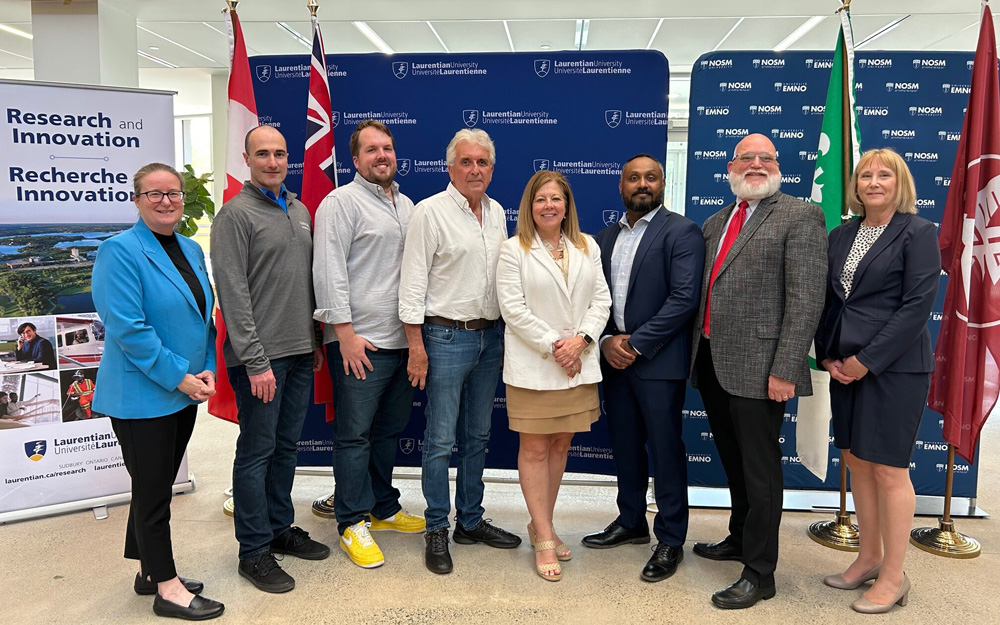News: Suppliers
15 May 2024
Canada’s NSERC awards grants worth $1.1m to research gallium extraction
Two researchers at Northern Ontario School of Medicine (NOSM) University and Laurentian University have been awarded funding from grants administered through the Natural Sciences and Engineering Research Council of Canada (NSERC) Alliance Missions program. One project studies how gallium can be mined more efficiently while the second project focuses on the extraction of critical minerals from tailings ponds.

Picture: (From left): Dr Tammy Eger, Chris Granger of Glencore, Dr Corey Laamanen, Dr John Ashley Scott, Sudbury MP Viviane Lapointe, Dr Sujeenthar Tharmalingam, Dr David Marsh, and Dr Lynn Wells at the announcement of the NSERC grant. (Photo: Laurentian University).
“The work of both Dr Tharmalingam and Dr Scott are vital to ensuring Canada plays a leading role in a net-zero world, while supporting economic growth, environmental rehabilitation, and job creation,” says Viviane Lapointe, Member of Parliament for Sudbury. “Critical minerals represent a generational opportunity for Sudbury and our net-zero future.”
Extracting gallium
Tharmalingam, assistant professor at NOSM University, was awarded $600,000 by NSERC to support his research project ‘A microbial sponge to mine the critical mineral gallium’.
The recent global semiconductor shortage has highlighted the need for alternative sources of gallium. China currently controls about 80% of the world's supply.
While gallium is not found naturally as a mineral, it exists in trace amounts in tailings ponds — the waste products from mining processes. However, existing methods for extracting gallium from these sources are expensive and inefficient.
Tharmalingam’s project, conducted in collaboration with Dr Vasu Appanna, co-founder of Biomine Ltd and a professor at Laurentian University, aims to develop a new and eco-friendly solution for gallium extraction. Building on their previous work, the research team will focus on more efficiently mining gallium using microbes.
The NSERC Alliance grant will help to develop a new microbial-based technology to collect gallium from tailings ponds in a clean and cost-effective manner. The project brings together Tharmalingam’s expertise in molecular biology, microbiology and gene editing with Biomine’s experience in developing custom-tailored eco-friendly microbial solutions.
It is reckoned that this research has the potential to revolutionize gallium mining by developing a sustainable process that provides a steady supply of this critical mineral.
“The significance of gallium in electronics manufacturing is underscored by the recent semiconductor shortage,” says Tharmalingam. “Our main objective is to pioneer an innovative microbial-based method to extract gallium from mining tailings, providing an environmentally friendly and economically viable solution to satisfy the increasing global need for this vital semiconductor material.”
Making the most of tailings ponds
Dr John Ashley Scott, full professor at Laurentian University’s Bharti School of Engineering, leads the project ‘Microalgal biosorption of critical minerals from mining related tailing ponds - recovering key metals to better protect aquatic systems and water supplies’, which will receive $530,990 from NSERC and substantial in-kind contributions from critical industry partner Glencore’s Sudbury Integrated Nickel Operations (Sudbury INO). Dr Corey Laamanen serves as the project’s co-investigator.
The project will use naturally occurring micro-algae bioprospected from mining sites in Northern Canada to remove critical minerals such as copper, nickel and cobalt from mining effluents using natural biosorption processes. It will also investigate methods for metals recovery from the biomass and beneficial uses of the remaining biomass, such as a soil ameliorant to aid in land rehabilitation.
The value to the critical minerals industry is that this low-cost approach will help with managing operational ponds and maximizing recovery of critical mineral resources. It can also act as a sustainable safeguard for protecting water supplies for regional communities, by continuing to ‘mop up’ metals and maintain post-closure legacy ponds to high standards to ensure long-term environmental protection, not just now but for future generations.
“This project may open up new opportunities for industry and environmental protection that simply haven’t been developed yet,” says Scott.
US Department of Energy releases 2023 Critical Materials Assessment









